The late baroque or rococo, with its distinctive sweetness and elegance, arises in architecture and visual art. The clothing has light pastel shades, and ruffles and accessories come back. Louis is not interested in state affairs or the poor people. His mistress, Madame de Pompadour, influences fashion: it is feminine, playful and airy. The Age of Enlightenment began, characterized by an informal clothing style with accessories and motifs from nature. There is civilized conversations and people read a lot.
The Rococo fashion was based on extravagance, elegance, refinement and decoration. Women’s fashion of the seventeenth-century was contrasted by the fashion of the eighteenth-century, which was ornate and sophisticated, the true style of Rococo. This time was known as the ‘Enlightenment’, which valued reason over authority. The influence for art, culture, and fashion shifted its’ centre from Versailles to Paris. The exuberant, playful, elegant style of decoration and design that we now know to be ‘Rococo’ was then known as ‘le style rocaille’, ‘le style moderne’, ‘le gout’.
A style that appeared in the early eighteenth-century was the 'robe volante', a flowing gown, that became popular towards the end of King Louis XIV’s reign. This gown had the features of a bodice with large pleats flowing down the back to the ground over a rounded petticoat. The colour palate was rich, dark fabrics accompanied by elaborate, heavy design features. After the death of Louis XIV the clothing styles began to change. The fashion took a turn to a lighter, more frivolous style, transitioning from the baroque period to the well-known style of Rococo. The later period was known for their pastel colours, more revealing frocks, and the plethora of frills, ruffles, bows, and lace as trims.
During the rococo the men's clothing will be less substantial. The tailored jacket has a flared back panel; the ruffles of the shirt come out. The stockings get a lighter color and the man wears black low shoes with a silver buckle. New is the English redingote, a buttoned long dressing gown. The wigs are less heavily powdered and white.
Men's fashion
Overview
Throughout the period, men continued to wear the coat, waistcoat and breeches of the previous period. However, changes were seen in both the fabric used as well as the cut of these garments. More attention was paid to individual pieces of the suit, and each element underwent stylistic changes. Under new enthusiasms for outdoor sports and country pursuits, the elaborately embroidered silks and velvets characteristic of "full dress" or formal attire earlier in the century gradually gave way to carefully tailored woollen "undress" garments for all occasions except the most formal. This more casual style reflected the dominating image of "nonchalance." The goal was to look as fashionable as possible with seemingly little effort. This was to be the new, predominant mindset of fashion.
1750s
Men: Coat; waistcoat: breeches; large cuffs; more attention on individual pieces of the suit; wigs for formal occasions; long and powdered hair
1760s
Men: Frock coat; knee length breeches fitted snugly; full shirt sleeves; original Macaroni
1770s
Men: Waistcoats began to shorten; Macaroni imitators
Coats
The skirts of the coat narrowed from the gored styles of the previous period. Waistcoats extended to mid-thigh to the 1770s and then began to shorten. Waistcoats could be made with or without sleeves.
As in the previous period, a loose, T-shaped silk, cotton or linen gown called a banyan was worn at home as a sort of dressing gown over the shirt, waistcoat, and breeches. Men of an intellectual or philosophical bent were painted wearing banyans, with their own hair or a soft cap rather than a wig.
A coat with a wide collar called a frock coat, derived from a traditional working-class coat, was worn for hunting and other country pursuits in both Britain and America.
Shirt and stock
Shirt sleeves were full, gathered at the wrist and dropped shoulder. Full-dress shirts had ruffles of fine fabric or lace, while undress shirts ended in plain wrist bands.
Breeches, shoes, and stockings
Knee-length breeches fitted snugly and had a fall-front opening.
Low-heeled leather shoes fastened with buckles were worn with silk or woollen stockings. Boots were worn for riding. The buckles were either polished metal, usually in silver (sometimes with the metal cut into false stones in the Paris style), or with paste stones, although there were other types. These buckles were often quite large and one of the world's largest collections can be seen at Kenwood House.
Hairstyles and headgear
Wigs were worn for formal occasions, or the hair was worn long and powdered, brushed back from the forehead and clubbed (tied back at the nape of the neck) with a black ribbon. Wigs were generally now short, but long wigs continued to be popular with the older generation. Wigs were made with a lot of white powder.
Wide-brimmed hats turned up on three sides called "cocked hats" (called tricorns in later eras) were worn in mid-century.
The macaroni
The trend of the macaroni grew out of the tradition of those who partook of the Grand Tour. Elite men in the 18th century would travel abroad across Europe, namely Italy, to broaden their cultural depth. These men adopted foreign fashions and tastes and brought them back to England where they interpreted them further. The original macaroni of the 1760s was characterized by elaborate dress consisting of short and tight trousers, large wigs, delicate shoes and small hats. As the general population of English males became exposed to the luxurious appeal of the macaroni trend, they began to adopt and replicate the trends they saw. By the 1770s, any man could appear as if they themselves had been on the Grand Tour based solely on their outward appearance.
The macaroni and the subsequent imitators were criticized for being gender ambiguous and effeminate. Frequently, the macaroni fashion trend was the subject of satirical caricatures and pamphlets. Their large costume like wigs and short coats, which deeply contrasted the masculine British dress of the time, were ridiculed for their frivolity and were said to be threatening the stability of gender difference, thereby undermining the nation's reputation. The question of farce and inauthenticity comes into play as well because by dressing as a macaroni, one claimed the status and the means of an elite who went on the Grand Tour.
Though many mocked the macaroni for their outwardly eccentric characteristics, some celebrated them for their commitment to the demonstration of personal identity. The idea of a unique character was becoming an important concept that spanned many types of media including books and prints as Britain wanted to distinguish itself from France.
Style gallery 1750–1775
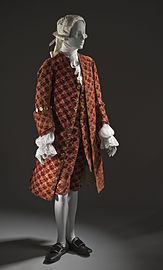
1 - c. 1755
| 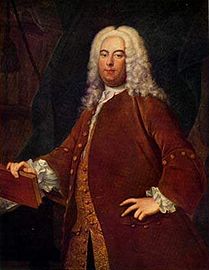
2 – 1756
| 
3 - 1750–60
| 
4 – 1761
| 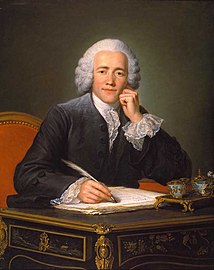
5 – 1761
|
|---|---|---|---|---|
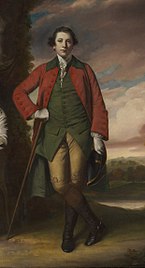
6 – c. 1762
| 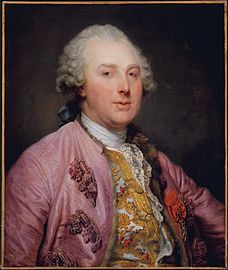
7 – c. 1763
| 
8 - 1764
| 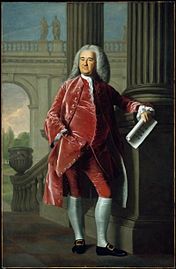
9 - 1764
| 
10 – 1766
|
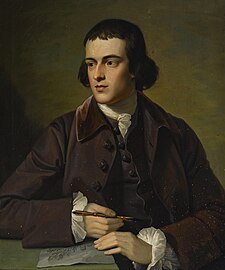
11 - 1766
| 
12 - 1767
| 
13 - 1772
| 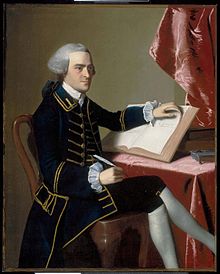
14-1764.
| 
15-1760
|
2.Portrait of George Frideric Handel in a dark red coat with deep cuffs worn over a long gold brocade vest or waistcoat. His shirt has full sleeves gathered at the wrists with ruffles, 1756.
3.Man's fitted double-breasted banyan, an at-home gown or informal coat, made in the Netherlands of Chinese silk, 1750–60. Los Angeles County Museum of Art, M.2007.211.797.
4.Suit of 1761 features a dark blue coat and waistcoat with fine embroidery on the edges, deep cuffs, and pocket flaps. Hair is tied back but not powdered. The waistcoat reaches to mid-thigh.
5.M. Gilbert DesVoisins, Councillor of State in Ordinary wears a shirt with front and wrist ruffles of fine lace. 1761
6.Informal country clothes of 1760–62. The long collared coat without cuffs is a frock.
7.Comte d'Angiviller wears a rose-coloured coat with a fur lining over a flowered white satin waistcoat with gold braid or embroidery. His shirt has a lace frill down the front. French fashion emphasizes rich fabrics over cut and tailoring, c. 1763.
8.Portrait of Lord Wodehouse wearing a deep blue coat, waistcoat and breeches, 1764.
9.Nathaniel Sparhawk of Maine wears a rose velvet suit with a collarless coat, 1764.
10.David Hume wears a reddish collarless dress coat and matching waistcoat trimmed with bands of gold. His shirt sleeves are gathered into wrist bands with tiny pleats (visible by his left hand) and have fine lace ruffles, 1766.
11.John Grey, third son of the Earl of Stamford, wears a brown coat and waistcoat over a linen shirt, 1766.
12.Denis Diderot wears a shot silk banyan over his waistcoat and shirt. The shirt fastens with buttons and buttonholes at the neck, details usually hidden by the stock, 1767.
13.Samuel Adams wears a plain coat with wide revers, a small stand-up collar, deep cuffs, and large pocket flaps. His shirt has small sleeve ruffles and is worn with a narrow stock, 1772.
14.John Hancock of Boston wears a coat with a collar, waistcoat, and breeches of deep blue trimmed in gold braid, 1764.
15.George Romney's Young Man with a Flute wears a gold figured waistcoat under his coat. His breeches have buttons and buckles at the knee, 1760s.
Source from Wikipedia
没有评论:
发表评论